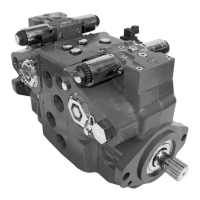Electrical Displacement Control (EDC)
EDC principle
An EDC is a displacement (flow) control. Pump swashplate position is proportional to the input command
and therefore vehicle or load speed (excluding influence of efficiency), is dependent only on the prime
mover speed or motor displacement.
The Electrical Displacement Control (EDC) consists of a pair of proportional solenoids on each side of a
three-position, four-way porting spool. The proportional solenoid applies a force input to the spool,
which ports hydraulic pressure to either side of a double acting servo piston. Differential pressure across
the servo piston rotates the swashplate, changing the pump‘s displacement from full displacement in
one direction to full displacement in the opposite direction. Under some circumstances, such as
contamination, the control spool could stick and cause the pump to stay at some displacement.
A serviceable 125 µm screen is located in the supply line immediately before the control porting spool.
EDC control
EDC schematic
Feedback from
Swash plate
PTF00B
M14
C1 C2
F00A
P003 478E
EDC operation
EDC’s are current driven controls requiring a Pulse Width Modulated (PWM) signal. Pulse width
modulation allows more precise control of current to the solenoids. The PWM signal causes the solenoid
pin to push against the porting spool, which pressurizes one end of the servo piston, while draining the
other. Pressure differential across the servo piston moves the swashplate.
A swashplate feedback link, opposing control links, and a linear spring provide swashplate position force
feedback to the solenoid. The control system reaches equilibrium when the position of the swashplate
spring feedback force exactly balances the input command solenoid force from the operator. As
hydraulic pressures in the operating loop change with load, the control assembly and servo/swashplate
system work constantly to maintain the commanded position of the swashplate.
The EDC incorporates a positive neutral deadband as a result of the control spool porting, preloads from
the servo piston assembly, and the linear control spring. Once the neutral threshold current is reached,
the swashplate is positioned directly proportional to the control current. To minimize the effect of the
control neutral deadband, we recommend the transmission controller or operator input device
incorporate a jump up current to offset a portion of the neutral deadband.
The neutral position of the control spool does provide a positive preload pressure to each end of the
servo piston assembly.
When the control input signal is either lost or removed, or if there is a loss of charge pressure, the spring-
loaded servo piston will automatically return the pump to the neutral position.
Basic Information
H1 Axial Piston Pumps, Single and Tandem
Operation
10 |
©
Danfoss | April 2017 11062168 | BC00000057en-US0602

